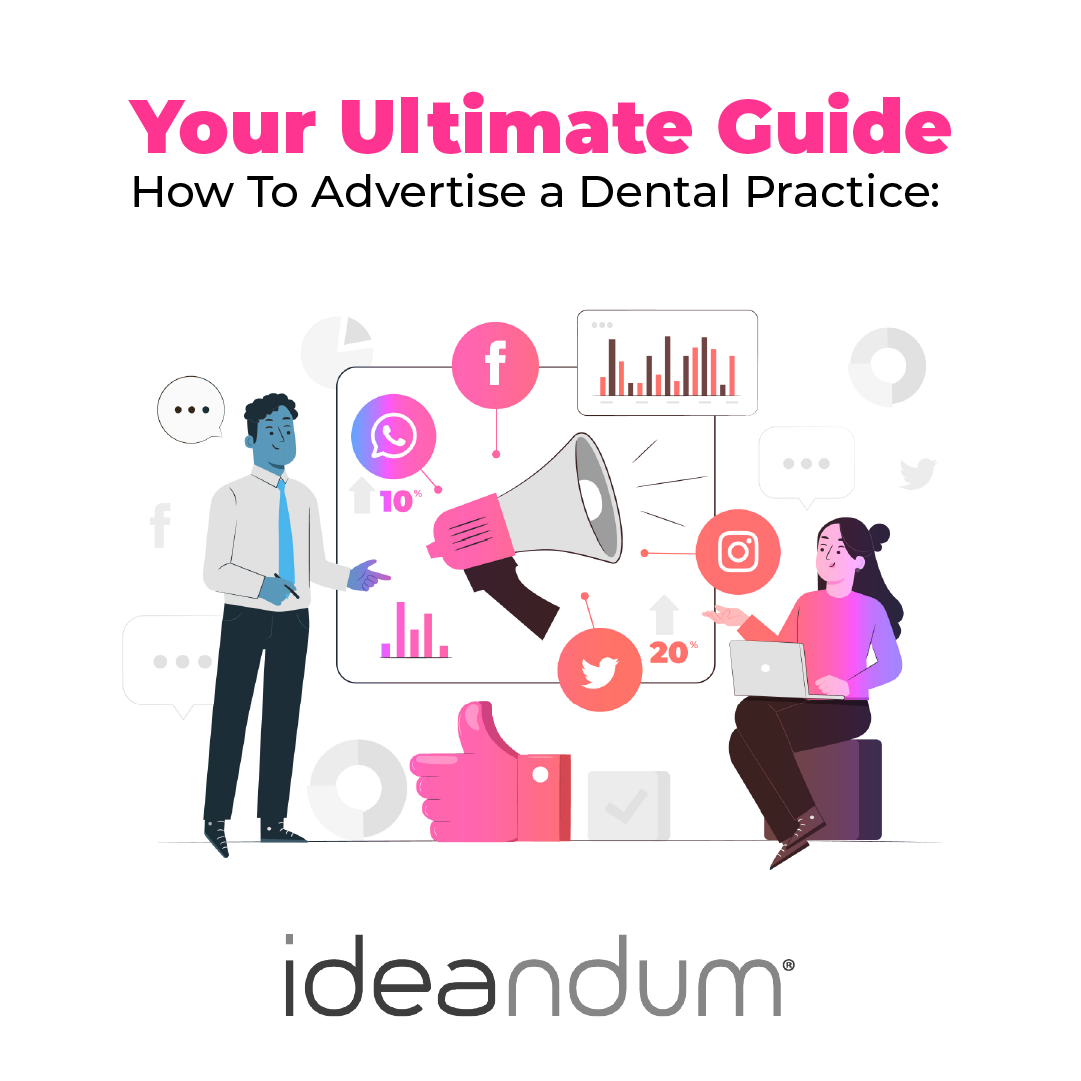Let’s now see practically how you can organise a dental marketing strategy.
The dental practice can utilise both traditional and digital advertising tools, provided that careful attention is given to the conveyed message and, not least, the objectives to be achieved.
The Dental Marketing Plan
Rule number one: do not improvise advertising campaigns or actions without first developing a communication plan that considers all essential aspects:
- Objectives of the advertising campaign: there is not just one objective, but multiple intermediate goals. All of them work together in sync to achieve your business goal (which could be acquiring more patients, increasing the average ticket, or expanding the audience for initial visits, etc.).
- Tools and channels to be utilised: the choice is not about “either Facebook or Instagram,” as each tool is suitable for achieving specific goals with specific strategies (e.g., you can acquire contacts on Facebook and increase visibility on Instagram).
- Allocating the budget: it is called a communication plan and budget because any investment must be measurable, sustainable, and yield a return on investment (ROI).
Advertising Tools for the Dental Practice
Once you have identified the dental marketing strategy that best suits your objectives, it’s time to choose the right channels.
It is essential to distinguish between advertising channels for
- internal marketing (communication within the dental practice and towards patients already acquired by the practice)
- external marketing (communication directed outside the practice to an audience that is not familiar with the practice or has not become an actual patient yet).
In both cases, you can use printed materials, press, TV, billboards, etc. (offline marketing), and all the formats available in the digital world: posts, blogs, websites, sponsored campaigns, social media pages, email marketing, etc. (online dental marketing or digital marketing for dentists).
Let’s explore in detail the main tools a dental practice can use for advertising.
1. Website and SEO
Your website is your home on the web: the only space you own, where you have the utmost freedom to present yourself, convey messages, images, offers, and valuable information. An effective dental website must be:
- Responsive: adapting to all devices it can be accessed from, including PCs, laptops, tablets, smartphones, and iPhones.
- Visually appealing: paying attention to images and graphic details, using original photos that represent your facility (avoid amateurish images that convey unprofessionalism) and colours that reflect your brand.
- Optimised for SEO: what’s the point of having a website if only a few people land on it? SEO (Search Engine Optimization) allows your website to be reachable through Google searches and helps you rank well not only on the web but also in the minds of potential customers.
2. Google My Business: "Business Profile on Google"
Google My Business listings help users discover and reach desired locations. Since your dental practice has a physical location, registering your business profile and managing its content allows your patients to find you easily. Moreover, by publishing posts, obtaining reviews, and optimising your profile, you can increase visibility on Google, the most widely used search engine in Italy.
The Google My Business profile is the right place to share images taken with smartphones (original and amateurish, yet well-curated).
3. Blog
The blog is the primary tool for content marketing: disseminating content written by you, original and useful for your patients and potential ones, is an excellent form of advertising for your dental practice. It has no campaign costs, is always available, and will give you more visibility and authority, improving your reputation (brand awareness).
Writing is not a simple activity, and despite the common belief that blogging has low costs (it’s free if you do it yourself), what you might not know is that:
- Writing for the web requires specific skills.
- The time you dedicate to writing is time taken away from work (hence it still has a cost).
- If you don’t plan the editorial calendar and SEO of the blog and its articles, you risk publishing lots of material that nobody will ever read.
4. Landing Pages
Landing pages are special pages on your website created ad hoc, and they are excellent lead generation tools.
If you want to advertise your website, you won’t be “only” interested in visibility.
At some point, you’ll want the website visitors to translate into potential patients (aka leads): a phone number, a name, an email to follow up with promotions and initiatives.
All of this can be obtained and profiled through this marketing tool.
5. Sponsored Campaigns
“Oh no, we don’t want to pay for advertising”: this mindset is wrong.
Remember that it’s not the tool that makes your communication “too salesy”, but the message you convey.
Google Ads and Facebook Ads are the main platforms to show your messages to a targeted audience (with specific characteristics). For example, if you want to spread the news that your practice is launching a prevention campaign for children this month, through Facebook Ads and Google Ads, you can target an audience geolocated in your area of interest (your municipality or province) and with specific interests (school, toys, etc.).
Also, don’t underestimate the possibility of retargeting: you can show up again to people who have already interacted with a page on your website or a specific campaign and display custom-made ads to renew the communication of a message and reinforce its impact.
6. Facebook, Instagram, and LinkedIn
Social media pages are your rented house: a virtual place not owned by you but where you can convey your image and messages, interacting with real people.
Social media pages bridge distances and are the most immediate means of gathering information about your dental practice.
As mentioned before, you can run sponsored campaigns for specific advertisements or choose to curate content to receive organic contacts (without paying advertising costs).
7. Email Marketing and Newsletter
Do you have a good email contact database? Have you collected useful characteristics for marketing activities for each contact?
Well, through specific platforms (Mailchimp, Hubspot, etc.), you can create targeted messages to reach only the people you want.
For instance, you can inform your clients with children that there will be a caries prevention meeting for baby teeth this month or present an innovative corrective orthodontic method.
Furthermore, you can suggest the latest articles from your blog, where you have discussed dental care for children.
8. Events, Seminars, and Conferences
Your dental practice is your best form of advertising.
Your collaborators, specialists, and experts can actively participate and help you organise scientific and informative meetings for specific patient categories.
9. Print, Radio, TV
Although traditional methods do not allow for measuring real impact, print, radio, and TV are valid advertising tools to enhance the reputation of your dental practice.
Use them with great care, both due to the costs (not exactly cheap) and to transmit a consistent and highly professional image (there’s a high risk of falling into low-quality commercial communication if you lack experience in this area).
10. Waiting Room Marketing
We have already discussed the importance of strategic management of the dental waiting room, including the importance of brochures. But that’s not all.
In the waiting area, you can carry out various marketing activities: from collecting reviews to using interactive devices to assess satisfaction levels, to creating informative videos displayed on monitors and devices.
Dental Marketing Mistakes to Avoid
If you are thinking of independently managing the advertising for your dental practice, here are the main mistakes to avoid:
- Not evaluating the subject, objectives, and tools of the advertising campaign.
- Not setting a sustainable budget.
- Not monitoring the results: you can’t improve what you can’t measure.
- Relying solely on prices and offers (carefully read the rules for correct healthcare advertising).
- Copying strategies from others that do not fit your value scale.
- Underestimating content marketing: are you afraid that people will read your content but not become patients? Meanwhile, you will be recognized as “authoritative” and position yourself in the user’s mind. This is beneficial for your image and brings along a lot of visibility and traffic for remarketing.
Before advertising dental services, consider dental advertising training from Ideandum.
One last advice you cannot ignore: before starting any marketing activity, take time to well-define and coordinate your image, logo, brand, values, mission, and your online presence (website + social media).
The rest is all about experience and professionalism that cannot be improvised!
Do you want to stand out from the crowd? Be unique?
Have an effective and engaging graphic identity for your audience?
Attract clients and grow your dental clinic’s business?
Trust experienced professionals like Ideandum! Contact Us


